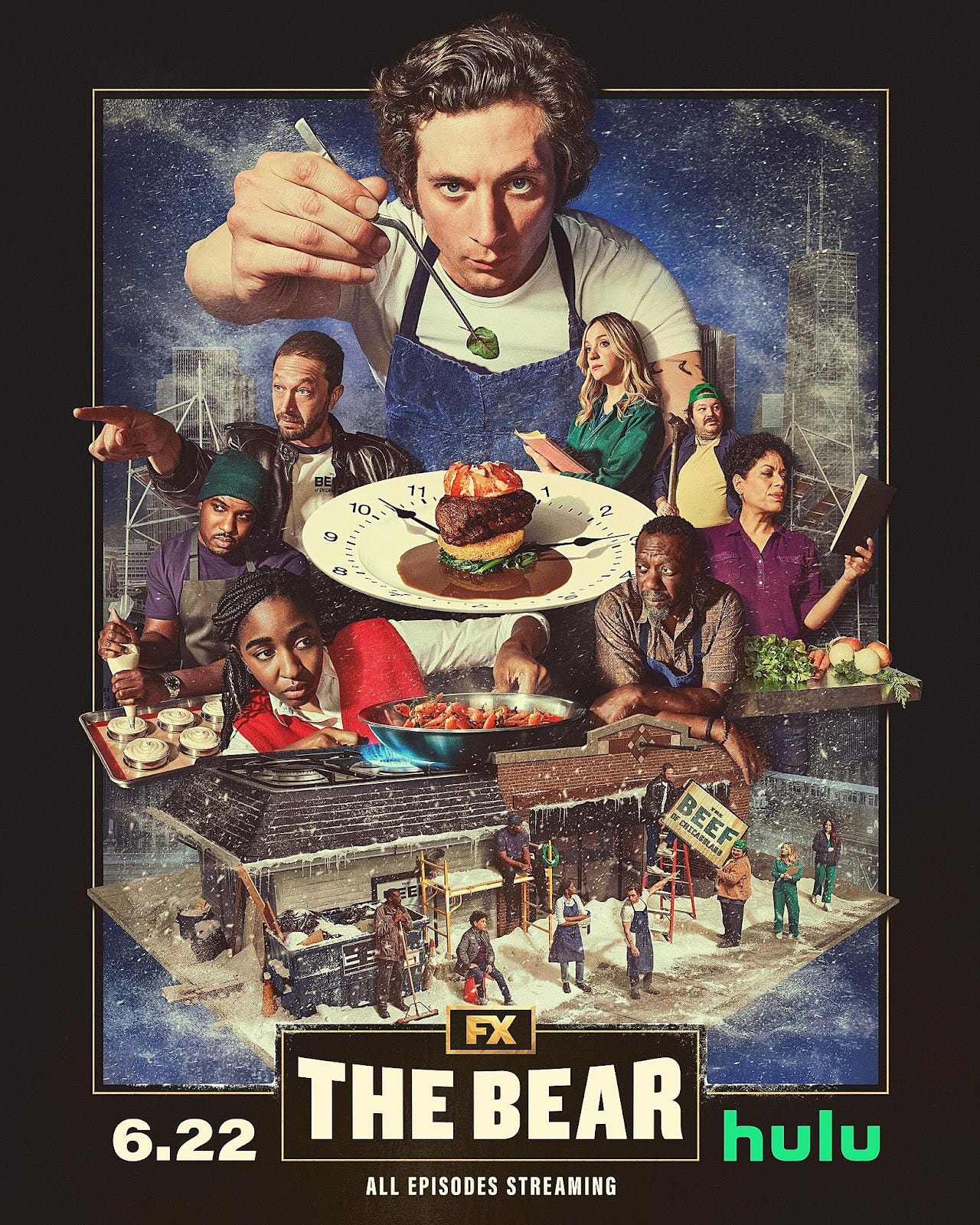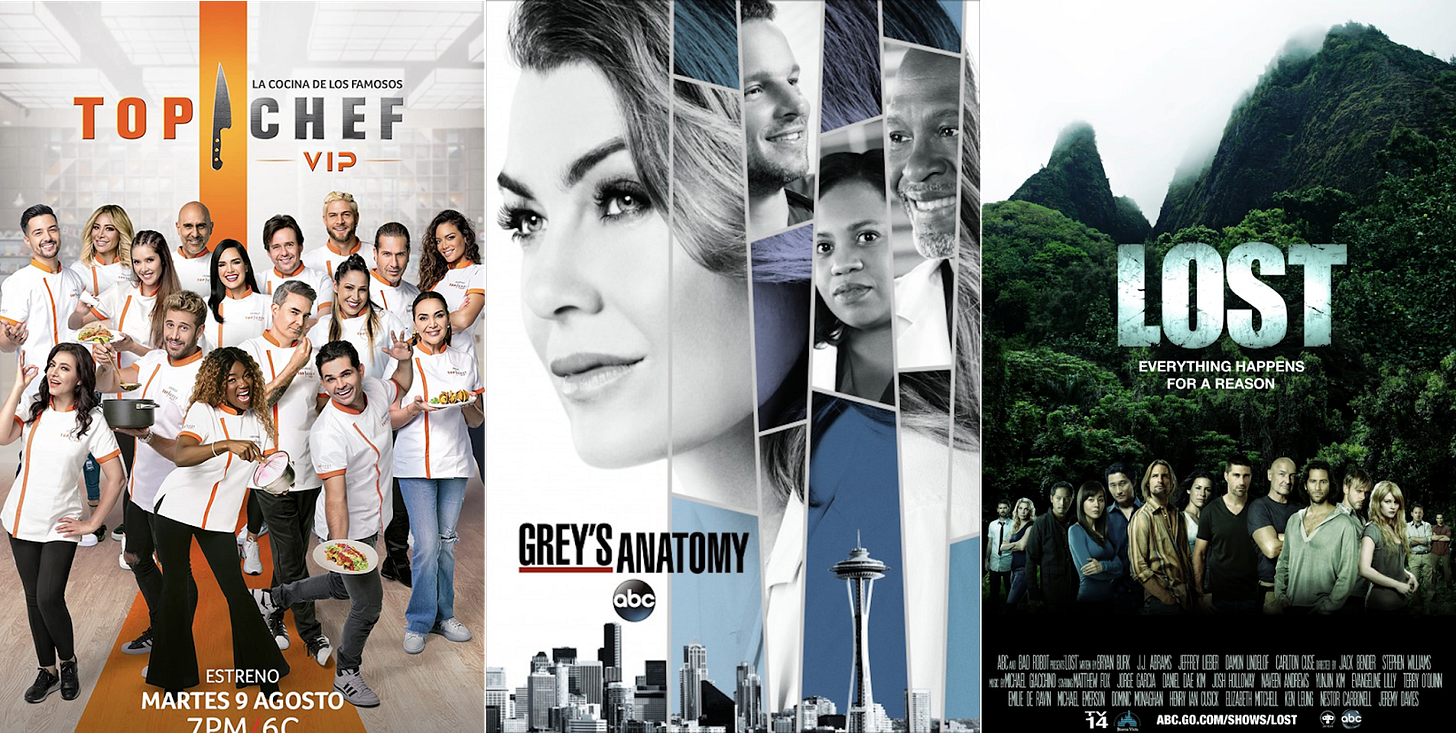[#6] The Bear Season 2
By Devki Pande
We’ve been Masterchef fans since we were fifteen years old. We would watch it on Star World on TV after dinner. Some favourite episodes included the Mystery Box challenges and the construction of crazy desserts - like the macaroon tower.
In food fiction, the focus is less on the food and more on the man making it. The man's genius and the pursuit of his craft have destroyed his personal life - and he is applauded for it. He is manic-depressive and violent towards others, and the secondary characters are there to unravel different parts of him. When the man achieves his redemption, they are made redundant.
The Power of the Secondary Character
But The Bear Season 2 is exceptional because the secondary characters don’t just buttress Carmen. Their arcs are fully-fledged stand-alone sagas.
At its essence, The Bear is about a group of misfits and how each misfit gets their due. For ex: In Season 1, Richie was the guy who created problems. In Season 2, he becomes the guy who solves them. The guy you turn to when things fall apart. The guy who says I Got You.
My favourite moment in the show was when Richie Gets it. On his way home, he rolls down the windows of his car and sings along to Love Story by Taylor Swift because he Gets It, in an explosion of abundance and joy. But it's not just Richie, it's also Sydney, who grows into her own and develops creative and leadership skills while struggling with significant self-doubt. It’s the veteran line cook, Tina, who realises that it’s never too late to realise a dream and goes back to school at 50 to become a sous chef.
It’s the whole of Episode 6 - an episode devoted entirely to tertiary characters. Through a Christmas dinner 5 years prior, the episode lays bare the ugliness of generational trauma. You never see these characters again. But each of them has a carefully developed history brimming under the surface with each other, which is what they throw at each other instead of knives at the dinner table.
There's one scene that underscores the focus on the secondary character. This scene caught my attention because it could have been so easily left on the edit table. With a clear head and a tail, this scene could have been cleanly chopped off, and no viewer would have been the wiser. And yet, it was allowed to be in the episode.
So this season, Marcus is working in the famed restaurant, Noma. He and Luca are talking to each other (an excellent cameo by Will Poulter) while kneading bread in the shape of morning croissants as the blue light of dawn filters in through the window. Luca is narrating a story about a guy who came to work at Noma several years ago. Luca thought he was competition and used every opportunity to come on top. But one day, he realised it was never about competition but about making each other better. It's a fiercely honest anecdote with no reason to be in the episode other than piercing authenticity.
This scene elevates the episode, and Season 2 is built around confessionals like this one. It's not like Marcus has to work for this story either. The experience is offered up with such generosity. And that’s what makes it healing.
The Role of a Secondary Character
Generally speaking, the secondary character is used as a tool for the main character to show his different facets. Even in Chef (2014), the best friend is simply - the best friend. Character A rubs the main character in a certain way, B Character shows a softer side to him, and Character C unravels his anger. It’s utilitarian. But in The Bear, each character has a massive, almost stubborn arc of self-improvement, separate from the effect they have on Carmen. It’s not just an 'ignorance to realisation' arc - which is internal, and what many stories tend to resort to, as a cop-out. The growth here is also external, so you have the characters not just introspecting but also assimilating and acting.
The food movie genre is an interesting environment, and clearly, one that people can’t get enough of. Even a film like Burnt, starring Bradley Cooper, which averaged a 2-star review, made double its money at the box office. Chef, starring Jon Favreau, made four times the amount. MasterChef Australia is currently on its 15th season and built on the spine of shows like Top Chef and Hell’s Kitchen, and both ran to 20+ seasons. Hunger, the Thai film about a street food chef who is hand-picked to join the number one restaurant in Bangkok was number one on Netflix globally. Even if it’s an average film, there’s something about food and restaurants that draw in the viewers.
What do Food Movies and Medical Dramas have in common?
This rage around food is similar to the rage around medical dramas 20 years ago. Grey's Anatomy, Scrubs, and Chicago Med are some examples. But medical dramas and food movies are actually very similar. What they have in common and what makes them binge-worthy is that both are high-pressure environments where everyone is in close proximity to each other. There’s no opportunity to hide.
There’s something about working in such environments which spawn intensely watchable storylines to the power n. The reason is that such environments have built-in points of pressure and adversity that are the anchor points of a good story.
This is also the reason why Lost did so well - the concept of people stranded on a desert island with only each other for company. And Reality TV like Splitsvilla and Big Boss is built on the premise that people stuck in the same house for months at a time will, at some point, want to kill each other. Big Boss is on its 16th season, and Splitsvilla is on its 14th season.
The insight is that high pressure environments, in which the characters are in close quarters with each other are fodder for stories. Accordingly, some environments that could be mined are:
Boarding schools
Armed forces training/ combat school (this is an environment dominated by Young Adult Fantasy, but not yet seen a lot in shows geared towards adults)
Circuses and Camps
Investment banking
Film sets




